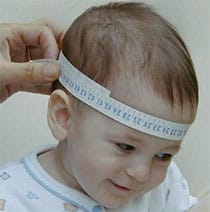 The idea of perimeter refers to the outline of a figure or a surface . Cephalic , meanwhile, is that linked to the head (the upper region of the body, where the brain is located).
The idea of perimeter refers to the outline of a figure or a surface . Cephalic , meanwhile, is that linked to the head (the upper region of the body, where the brain is located).
As can be seen from these definitions, the concept of head circumference refers to the contour of the head . This is a measurement that is carried out in children , considering the distance that extends from the area above the ears and eyebrows to the back.
The process is carried out with a tape measure . The tape should be placed over the ears and eyebrows and surround the entire contour of the head.
By measuring the head circumference, the pediatrician can analyze the infant's development . Each new data is compared with the patient's previous measurements of the head circumference and with the values considered normal according to the child's age and sex, with deadlines that are counted in weeks or months.
Measuring head circumference, in short, is part of a child's routine check-ups . The doctor expects some head growth which, if not reflected in these checks, may reveal a possible disorder.
The head circumference must grow especially between the first two and three years of life, since then neuronal connectivity increases more than ever. Let's look at the specific values that doctors expect to find after measuring children up to one year old: the first three months, the head circumference is expected to grow 2 centimeters per month; between the third and sixth month, 1 centimeter per month; Between six months and a year, it should grow 0.5 centimeters per month.
Regarding the weight of the brain, in a newborn baby it should be approximately 350 grams, while in an adult of about 20 years old, 1350 grams. As mentioned in the previous paragraph, throughout the first three years of life, the growth of this part of the body is given with special emphasis: at six months, for example, it reaches 50 percent of its total weight. ; per year, 60 percent; at eighteen months, 75 percent.
A smaller than normal head, for example, could reflect slow growth or microcephaly . On the other hand, a head that is too large may be a sign of hydrocephalus .
 With respect to microcephaly, we can say that most cases are recorded because the brain does not grow at a rate considered normal, since this anomaly directly affects the development of the skull, something that occurs during pregnancy and breastfeeding. Some of the most common causes are the following: uncontrolled maternal phenylketonuria ; methylmercury poisoning; congenital rubella; congenital cytomegalovirus.
With respect to microcephaly, we can say that most cases are recorded because the brain does not grow at a rate considered normal, since this anomaly directly affects the development of the skull, something that occurs during pregnancy and breastfeeding. Some of the most common causes are the following: uncontrolled maternal phenylketonuria ; methylmercury poisoning; congenital rubella; congenital cytomegalovirus.
It can also arise due to various syndromes, such as Cornelia de Lange, cat's meow, Down, Rubinstein-Taybi, Seckel or Smith-Lemli-Opitz, as well as types 18 and Trisomy 21. On the other hand, there is hydrocephalus, which is characterized by excess fluid accumulation in the skull.
It is worth mentioning that in the past hydrocephalus was known as "water on the brain" although in reality it is cerebrospinal fluid, which is found around the spinal cord and brain.
It should be noted that the World Health Organization ( WHO ) prepares tables with the expected head circumference according to the age of boys and girls. These data are taken as healthy patterns of child growth and serve as standards for pediatricians.
